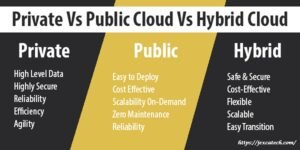Public Cloud vs Private Cloud vs Hybrid Cloud: Understanding the Differences

Introduction Public Cloud vs Private Cloud vs Hybrid Cloud.
The demand for cloud computing has grown exponentially as organizations seek scalable, flexible, and cost-effective solutions for their IT needs. Among the many options available, public, private, and hybrid clouds are the three main types of cloud environments that organizations can choose from, each with its unique features, benefits, and challenges. This article explores the differences between public, private, and hybrid clouds, helping businesses make informed decisions based on their specific needs.
Public Cloud vs Private Cloud vs Hybrid Cloud, What is Cloud Computing?
Before diving into the different types of cloud environments, it’s essential to understand what cloud computing is. Cloud computing refers to the delivery of computing services—including storage, processing power, networking, software, and databases—over the internet (“the cloud”). These services are typically provided by cloud service providers (CSPs) such as Amazon Web Services (AWS), Microsoft Azure, and Google Cloud Platform (GCP).
Cloud computing offers several benefits, including cost savings, flexibility, scalability, and enhanced collaboration. Organizations can choose from various deployment models to align with their business objectives and regulatory requirements: public cloud, private cloud, and hybrid cloud.

Public Cloud
Definition
The public cloud is a cloud environment where cloud resources are owned, operated, and maintained by third-party cloud service providers. These resources—such as servers, storage, and applications—are shared among multiple customers and accessed over the Internet. The most popular public cloud providers include AWS, Microsoft Azure, and Google Cloud.
Features of Public Cloud
- Shared Infrastructure: Resources are shared among multiple users, known as tenants, which reduces costs.
- On-Demand Scalability: Users can quickly scale resources up or down based on demand, making it ideal for fluctuating workloads.
- Pay-As-You-Go Model: Customers pay only for the resources they use, reducing upfront capital expenses.
- Accessibility: Public clouds are accessible from anywhere with an internet connection, making them suitable for remote work and global operations.
- Managed Services: Cloud service providers handle maintenance, updates, and security, reducing the administrative burden on organizations.
Benefits of Public Cloud
- Cost Efficiency: The shared nature of public cloud infrastructure means that the costs are spread across multiple tenants, leading to lower prices for individual customers.
- Flexibility and Agility: Organizations can quickly deploy new applications and services without the need to invest in hardware or infrastructure.
- Global Reach: Public cloud providers have a global network of data centers, allowing businesses to expand into new regions easily.
- Managed Services and Automation: Many public cloud providers offer a range of managed services, such as databases, analytics, and AI tools, which can save time and reduce complexity.
Drawbacks of Public Cloud
- Security Concerns: The shared infrastructure of the public cloud may raise security and compliance concerns, especially for industries with stringent regulatory requirements.
- Limited Control: Organizations have limited control over the underlying infrastructure, which may not be suitable for all workloads.
- Latency Issues: Applications that require low latency may face challenges if the cloud provider’s data center is far from the user’s location.
Private Cloud
Definition
The private cloud is a cloud environment dedicated exclusively to a single organization. Unlike the public cloud, private cloud infrastructure is owned, managed, and operated by the organization itself or a third-party service provider. Private clouds can be hosted on-premises or in a data center.
Features of Private Cloud
- Dedicated Infrastructure: Resources are dedicated to a single organization, providing greater control and customization options.
- Enhanced Security and Compliance: Private clouds are ideal for organizations with strict security, privacy, and compliance requirements.
- Customization: Organizations have full control over the cloud environment, allowing for tailored configurations to meet specific business needs.
- Isolation: Unlike public clouds, private clouds are isolated environments, reducing the risk of data breaches due to multi-tenancy.
Benefits of Private Cloud
- Greater Control and Flexibility: Organizations have complete control over their cloud environment, enabling them to customize hardware, software, and security settings.
- Improved Security and Compliance: Private clouds offer a higher level of security and compliance compared to public clouds, making them suitable for regulated industries like healthcare, finance, and government.
- Performance Optimization: Organizations can optimize their private cloud infrastructure to deliver higher performance for specific workloads.
- Data Sovereignty: Private clouds allow organizations to keep sensitive data on-premises or within specific geographical locations to comply with data sovereignty laws.
Drawbacks of Private Cloud
- High Costs: Private clouds require significant capital investment in hardware, software, and maintenance, making them more expensive than public clouds.
- Limited Scalability: Scaling a private cloud involves additional investments in infrastructure, which can be time-consuming and costly.
- Maintenance and Management: Organizations are responsible for maintaining and managing the cloud infrastructure, requiring specialized skills and resources.
Hybrid Cloud
Definition
A hybrid cloud is a combination of public and private cloud environments that are interconnected to provide greater flexibility, optimized performance, and cost savings. A hybrid cloud allows organizations to take advantage of both public and private cloud benefits while mitigating their respective drawbacks.
Features of Hybrid Cloud
- Integration of Public and Private Clouds: Hybrid cloud environments enable seamless integration between public and private clouds, allowing data and applications to move between them as needed.
- Workload Optimization: Organizations can run sensitive or mission-critical workloads on private clouds while leveraging the scalability and cost benefits of public clouds for less sensitive workloads.
- Flexibility and Adaptability: Hybrid clouds offer the flexibility to adapt to changing business needs, such as sudden increases in demand or new regulatory requirements.
- Unified Management: Hybrid cloud solutions often provide unified management tools to monitor and control resources across both public and private environments.
Benefits of Hybrid Cloud
- Cost Efficiency: Organizations can optimize costs by running non-sensitive workloads on the public cloud while keeping sensitive data and applications in the private cloud.
- Scalability: Hybrid clouds provide the scalability of public clouds while retaining the control and security of private clouds.
- Improved Business Continuity: By using a hybrid cloud strategy, organizations can ensure business continuity through backup and disaster recovery solutions.
- Regulatory Compliance: Hybrid clouds enable organizations to store sensitive data in private clouds while taking advantage of public clouds’ capabilities, helping them comply with data privacy regulations.
Drawbacks of Hybrid Cloud
- Complexity: Managing a hybrid cloud environment can be complex, requiring expertise in both public and private cloud management.
- Integration Challenges: Integrating public and private cloud environments requires careful planning to ensure seamless interoperability and avoid potential security vulnerabilities.
- Security Risks: While hybrid clouds offer greater control, they also introduce potential security risks when moving data and applications between environments.
Key Differences Between Public, Private, and Hybrid Clouds
| Feature | Public Cloud | Private Cloud | Hybrid Cloud |
|---|---|---|---|
| Ownership | Third-party cloud service provider | Owned by a single organization | Combination of public and private clouds |
| Cost Model | Pay-as-you-go | High initial investment | Variable costs, combining both models |
| Scalability | Highly scalable | Limited by on-premises resources | Scalable, leveraging both public and private |
| Security | Shared responsibility model | High level of control and security | Balance of security based on workload type |
| Management | Managed by the service provider | Managed by the organization | Requires management of both environments |
| Flexibility | Highly flexible for diverse workloads | Highly customizable, but limited scalability | Offers a balance of flexibility and control |
| Compliance | May not meet all regulatory requirements | Suitable for industries with strict compliance | Provides flexible options for compliance |
Choosing the Right Cloud Environment
The choice between public, private, and hybrid cloud environments depends on several factors, including an organization’s size, budget, regulatory requirements, and specific business needs.
- Public Cloud: Best suited for organizations looking for cost-effective, scalable solutions without the need for extensive control over infrastructure. Ideal for startups, small businesses, and non-sensitive workloads.
- Private Cloud: Suitable for enterprises with strict security, privacy, and compliance requirements. Ideal for industries such as healthcare, finance, and government, where data protection is paramount.
- Hybrid Cloud: Best for organizations seeking a balance between cost, control, and scalability. Hybrid clouds are ideal for businesses with varying workloads, data sensitivity levels, and dynamic IT needs.
Conclusion
Understanding the differences between Public Cloud vs Private Cloud vs Hybrid Cloud is crucial for businesses looking to leverage cloud computing effectively. Each cloud model offers unique advantages and challenges, and the right choice depends on an organization’s specific needs and objectives. By carefully evaluating the features, benefits, and drawbacks of each cloud environment, businesses can make informed decisions that align with their strategic goals and enhance their overall IT capabilities. Public Cloud vs Private Cloud vs Hybrid Cloud Who is the Best?
Also, Read About. The Future of Cloud Computing: Top Trends for 2024.





